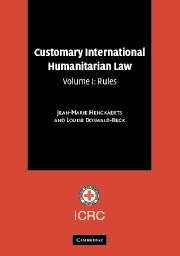Book contents
- Frontmatter
- Contents
- Foreword by ICRC President Jakob Kellenberger
- Foreword by Judge Abdul G. Koroma
- Foreword by Yves Sandoz
- Acknowledgements
- Introduction
- List of abbreviations
- Part I The Principle of Distinction
- Chapter 1 Distinction between Civilians and Combatants (Rules 1–6)
- Chapter 2 Distinction between Civilian Objects and Military Objectives (Rules 7–10)
- Chapter 3 Indiscriminate Attacks (Rules 11–13)
- Chapter 4 Proportionality in Attack (Rule 14)
- Chapter 5 Precautions in Attack (Rules 15–21)
- Chapter 6 Precautions against the Effects of Attacks (Rules 22–24)
- Part II Specifically Protected Persons and Objects
- Part III Specific Methods of Warfare
- Part IV Weapons
- Part V Treatment of Civilians and Persons Hors De Combat
- Part VI Implementation
Chapter 1 - Distinction between Civilians and Combatants (Rules 1–6)
Published online by Cambridge University Press: 05 June 2012
- Frontmatter
- Contents
- Foreword by ICRC President Jakob Kellenberger
- Foreword by Judge Abdul G. Koroma
- Foreword by Yves Sandoz
- Acknowledgements
- Introduction
- List of abbreviations
- Part I The Principle of Distinction
- Chapter 1 Distinction between Civilians and Combatants (Rules 1–6)
- Chapter 2 Distinction between Civilian Objects and Military Objectives (Rules 7–10)
- Chapter 3 Indiscriminate Attacks (Rules 11–13)
- Chapter 4 Proportionality in Attack (Rule 14)
- Chapter 5 Precautions in Attack (Rules 15–21)
- Chapter 6 Precautions against the Effects of Attacks (Rules 22–24)
- Part II Specifically Protected Persons and Objects
- Part III Specific Methods of Warfare
- Part IV Weapons
- Part V Treatment of Civilians and Persons Hors De Combat
- Part VI Implementation
Summary
Rule 1. The parties to the conflict must at all times distinguish between civilians and combatants. Attacks may only be directed against combatants. Attacks must not be directed against civilians.
Practice
Volume II, Chapter 1, Section A.
Summary
State practice establishes this rule as a norm of customary international law applicable in both international and non-international armed conflicts. The three components of this rule are interrelated and the practice pertaining to each of them reinforces the validity of the others. The term “combatant” in this rule is used in its generic meaning, indicating persons who do not enjoy the protection against attack accorded to civilians, but does not imply a right to combatant status or prisoner-of-war status (see Chapter 33). This rule has to be read in conjunction with the prohibition to attack persons recognised to be hors de combat (see Rule 47) and with the rule that civilians are protected against attack unless and for such time as they take a direct part in hostilities (see Rule 47). Belligerent reprisals against civilians are discussed in Chapter 41.
International armed conflicts
The principle of distinction between civilians and combatants was first set forth in the St. Petersburg Declaration, which states that “the only legitimate object which States should endeavour to accomplish during war is to weaken the military forces of the enemy”.
- Type
- Chapter
- Information
- Customary International Humanitarian Law , pp. 3 - 24Publisher: Cambridge University PressPrint publication year: 2005
- 3
- Cited by

